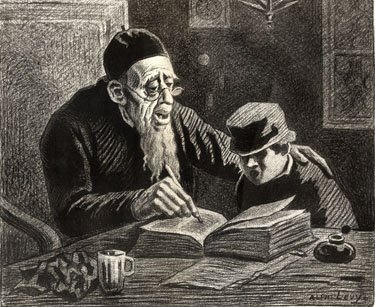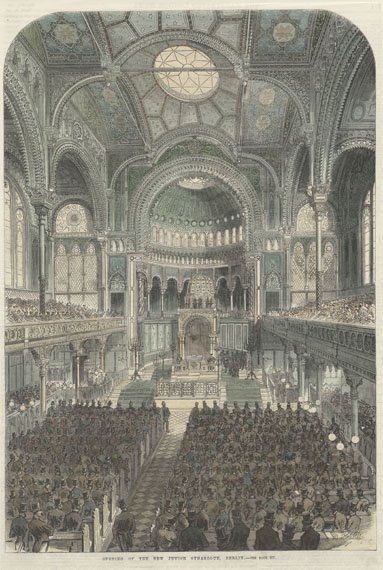Study and Worship

Alphonse Lévy (1843-1918) Lithograph, ca. 1903
Both the written and the spoken word have enormous importance in Jewish religious practice. One of the foundational prayers, for example, is the Shema, which starts with an exhortation to listen ("Hear, oh Israel!"); and congregations treasure the Torah scrolls upon which the five books of Moses are carefully handwritten by highly trained scribes. The Torah is read at least weekly (every Shabbat and more often when other holidays intervene) and each movement of the Torah in and out of its ark, as well as the beginning and end of every reading, is marked by prayer. (See the discussion of Simchat Torah in Feast of Tabernacles section.)
It is not only the ceremonial reading of the Torah, however, that bears weight in Judaism. Study of Jewish law and Jewish texts and commentaries is an obligation of every Jew, considered as important as prayer, the keeping of dietary and clothing rules, and other practices.
Given the centrality of the book to Jewish practice, it is not surprising that some of the most striking Jewish artistic endeavors are to be found within their covers and that many Jewish homes contained at least a few beautifully bound books, including both prayer books and printed guides to living well as a Jew. Images of Jews praying and studying, sometimes joyfully, sometimes somberly, are also omnipresent in visual depictions of European Jewry; and these genres are well represented in the Sondheim collection.

The Illustrated London News, Sept. 22, 1866
The Synagogue
Jewish places of worship all share a few attributes: they have a place to store one or more Torah scrolls; a table, desk or pedestal from which the Torah is read, and seats for the congregation. Beyond those fundamental requirements, they varied greatly in size and form depending on the specific ritual used by their congregations, the economic and aesthetic resources to which those congregations had access, and the civil regulations to which they were subject. Some were as basic as a single room, furnished with rough benches and little light, while others were vast, highly elaborate buildings, richly decorated with carved furniture, inscriptions, draperies, and even stained glass. Synagogues have been built in nearly every architectural style; and there are many examples of Jewish communities taking over buildings no longer needed by other religious groups, as well as synagogues being converted into churches or mosques.
Since the interior of synagogues shapes the religious practices
performed there, and their external form represents the congregation to
the community in which it stands, it is not surprising that synagogue
architecture has been the subject of intense debate within the Jewish
world. The location of the bimah (the pulpit), the
appropriateness of an organ, the separation of men's and women's
seating, the ostentation or austerity of the street-side façade, have
all been hotly contested and continue to vary greatly from one
congregation to another.
